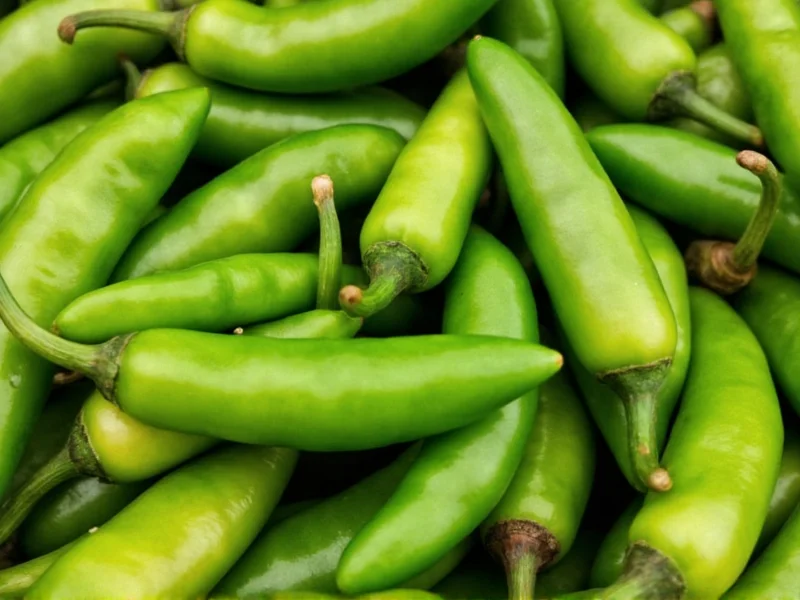Understanding Green Chilies: Nature's Fresh Heat
When you encounter green chilies at the market, you're seeing chili peppers in their immature stage. Unlike red chilies which have fully ripened on the plant, green varieties are picked early, preserving their characteristic bright color and distinct flavor profile. This harvesting technique creates peppers with unique culinary properties that differ significantly from their mature versions.
Common Varieties of Green Chilies
Not all green chilies are created equal. Different pepper varieties offer distinct heat levels and flavor characteristics that make them suitable for specific culinary applications. Understanding these differences helps home cooks and professional chefs select the right pepper for their recipes.
| Pepper Variety | Scoville Heat Units | Flavor Profile | Common Culinary Uses |
|---|---|---|---|
| Jalapeño | 2,500-8,000 SHU | Grassy, slightly sweet with vegetal notes | Salsas, nachos, poppers, pickled preparations |
| Serrano | 10,000-23,000 SHU | Sharp, bright, more intense heat than jalapeño | Pico de gallo, hot sauces, guacamole |
| Poblano | 1,000-2,000 SHU | Earthy, mild with subtle fruitiness | Chiles rellenos, mole sauces, stuffing |
| Anaheim | 500-2,500 SHU | Mild, slightly sweet with minimal heat | Rojos, stuffed peppers, mild salsas |
| Habanero (green) | 100,000-350,000 SHU | Floral, citrusy with intense heat | Specialty hot sauces, Caribbean cuisine |
Nutritional Benefits of Green Chilies
Green chilies pack impressive nutritional value beyond their heat. A single medium jalapeño (about 14g) contains approximately 4 calories, 0.1g protein, and 0.7g carbohydrates. More importantly, they're rich in vitamin C (providing about 12% of your daily needs per pepper), vitamin A, and capsaicin—the compound responsible for their heat that also offers potential health benefits.
Research suggests capsaicin may support metabolism, reduce inflammation, and provide pain relief when used appropriately. The vitamin C content in green chilies actually exceeds that found in oranges by weight, making them an excellent source of this essential nutrient. Additionally, these peppers contain antioxidants like lutein and zeaxanthin that support eye health.
Culinary Applications and Preparation Techniques
Chefs worldwide utilize green chilies for their ability to add complex flavor dimensions to dishes. The heat level in green chilies can be controlled through various preparation methods. Removing seeds and white membranes significantly reduces spiciness, while roasting develops deeper, sweeter flavors through caramelization.
In Mexican cuisine, roasted poblano peppers become 'chiles pasados' when dried, while fresh jalapeños feature prominently in salsas verdes. Indian cooking often uses green chilies as a fundamental flavor base in curries and chutneys. Thai cuisine incorporates bird's eye chilies for intense heat in many traditional dishes.
When working with extremely hot varieties like habaneros, always wear gloves to prevent skin irritation. Never touch your face after handling hot peppers, and remember that cooking doesn't eliminate capsaicin—it merely distributes it throughout your dish.
Green vs. Red Chilies: Understanding the Difference
The color difference between green and red chilies represents different stages of ripeness rather than different species. All chili peppers start green and change color as they mature. Green chilies are harvested early, while red chilies remain on the plant until fully ripe.
This ripening process creates significant flavor differences. Green chilies typically have a brighter, more vegetal flavor with grassy notes, while red chilies develop sweeter, fruitier characteristics with deeper, more complex flavors. The heat level also changes—some varieties become hotter as they ripen, while others mellow slightly.
From a nutritional standpoint, red chilies generally contain higher concentrations of certain antioxidants and vitamins due to longer sun exposure, but green chilies maintain higher vitamin C content. The choice between green and red ultimately depends on the specific flavor profile you want to achieve in your cooking.
Growing Your Own Green Chilies
Cultivating green chilies at home is accessible even for beginner gardeners. Most chili varieties thrive in warm climates with plenty of sunlight. Start seeds indoors 8-10 weeks before the last frost, then transplant outdoors when soil temperatures reach at least 70°F (21°C).
Harvest green chilies when they reach full size but remain bright green—typically 60-80 days after planting, depending on variety. Regular harvesting encourages continued production throughout the growing season. For container gardening, choose compact varieties like 'Jalafuego' or 'Thai Hot' which adapt well to pot culture.











 浙公网安备
33010002000092号
浙公网安备
33010002000092号 浙B2-20120091-4
浙B2-20120091-4